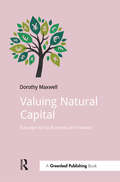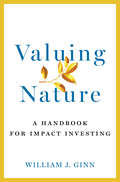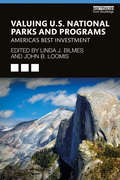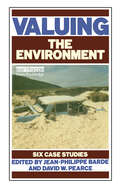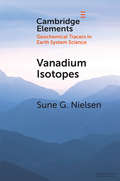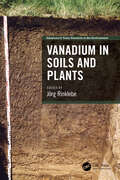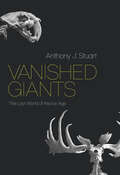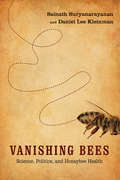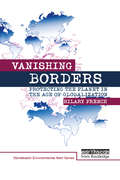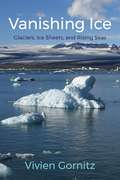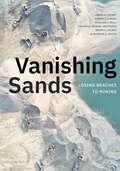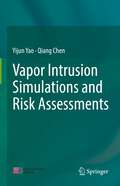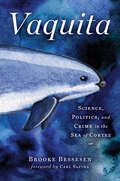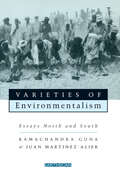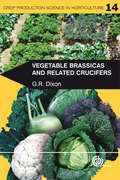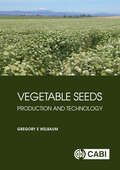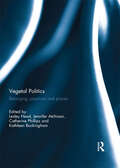- Table View
- List View
Valuing Natural Capital: Future Proofing Business and Finance (Doshorts Ser.)
by Dorothy MaxwellCompanies that will succeed in the long-term are integrating natural and social capital into their business model now. Natural capital, the resources and critical support services nature provides, underpins our entire global economy. Yet despite its vast social and economic value, the many benefits of natural capital are often assumed to be "free". The future shock for business is the potential for profit to be wiped out as natural capital is internalized through regulation and markets. Freshwater, forests and biodiversity are being consumed at an alarming rate, and critical support systems such as the ability to regulate climate are failing. As these and other sustainability challenges develop, businesses and their investors need to understand their role in maintaining natural capital and their natural capital risks and opportunities. The language of finance provides a useful approach for communicating trade-offs and prioritizing sustainability at CFO, CEO and board level: companies who "future-proof" now will position themselves to thrive in a resource-constrained world. They will mitigate risk, secure their resource supplies, create long-term value and enhance their resilience, reputation and competitive advantage. This book provides a succinct introduction to natural capital: what natural capital is and how it links to other capitals; the business case for using it in decision-making; where natural capital accounting and valuation fit in the sustainability and financial toolbox; and what real life early adopters of natural capital in business are doing. Views from natural capital leaders across business, finance, accounting, government, research and NGO communities illustrate the theory with practice. Included: Quotes and case examples from CFOs, CEOs and Heads of Sustainability in early adopter businesses (Kingfisher Group, Dow Chemical Company, The Crown Estate, Patagonia®, United Utilities and Marks & Spencer) and financial institutions (Inter-American Development Bank, Citi Group and Credit Suisse).
Valuing Nature: A Handbook for Impact Investing
by William GinnAs the world faces unprecedented challenges such as climate change and biodiversity loss, the resources needed far outstrip the capabilities of nonprofits and even governments. Yet there are seeds of hope—and much of that hope comes from the efforts of the private sector. Impact investing is rapidly becoming an essential tool, alongside philanthropy and government funding, in tackling these major problems. Valuing Nature presents a new set of nature-based investment areas to help conservationists and investors work together.NatureVest founder William Ginn outlines the emerging private sector investing opportunities in natural assets such as green infrastructure, forests, soils, and fisheries. The first part of Valuing Nature examines the scope of nature-based impact investing while also presenting a practical overview of its limitations and the challenges facing the private sector. The second part of the book offers tools for investors and organizations to consider as they develop their own projects and tips on how nonprofits can successfully navigate this new space. Case studies from around the world demonstrate how we can use private capital to achieve more sustainable uses of our natural resources without the unintended consequences plaguing so many of our current efforts.Valuing Nature provides a roadmap for conservation professionals, nonprofit managers, and impact investors seeking to use market-based strategies to improve the management of natural systems.
Valuing U.S. National Parks and Programs: America’s Best Investment
by Linda J. Bilmes John B. LoomisThis book provides the first comprehensive economic valuation of U.S. National Parks (including monuments, seashores, lakeshores, recreation areas, and historic sites) and National Park Service (NPS) programs. The book develops a comprehensive framework to calculate the economic value of protected areas, with particular application to the U.S. National Park Service. The framework covers many benefits provided by NPS units and programs, including on-site visitation, carbon sequestration, and intellectual property such as in education curricula and filming of movies/ TV shows, with case studies of each included. Examples are drawn from studies in Santa Monica Mountains National Recreation Area, Golden Gate National Recreation Area, Everglades National Park, and Chesapeake Bay. The editors conclude with a chapter on innovative approaches for sustainable funding of the NPS in its second century. The framework serves as a blueprint of methodologies for conservationists, government agencies, land trusts, economists, and others to value public lands, historical sites, and related programs, such as education. The methodologies are relevant to local and state parks, wildlife refuges, and protected areas in developed and developing countries as well as to national parks around the world. Containing a series of unique case studies, this book will be of great interest to professionals and students in environmental economics, land management, and nature conservation, as well as the more general reader interested in National Parks.
Valuing the Environment: Six Case Studies (Environmental and Resource Economics Set)
by Jean-Philippe Barde David W. PearceThis is the second in a pair of economic texts commissioned by the OECD in the field of environmental economics; The Pearce Report: Blueprint for a Green Economy puts the role which monetary evaluation of environmental costs and benefits can play firmly into the public eye. This book goes further and looks at six countries where such evaluation techniques are applied and at the obstacles to their further use. The case studies, written by leading experts in each nation, show how these methods are being taken up in the UK, Norway and Italy and the ways in which they are already extensively in use in the USA, Germany and the Netherlands. The authors also describe the obstacles to their use - the lack of knowledge of environmental economics at government level; the competition from other government priorities; and, the failure of environmental groups to grasp the importance of financial evaluation to their cause. But, as this book makes clear, significant advances are being made, both in the implementation of these economic techniques and, above all, in striking and yet further developments in economic thinking.
Valuing the Environment: Six case studies (Environmental And Resource Economics Set Ser.)
by Jean-Philippe Barde David W. PearceThe 'Pearce Report', Blueprint for a Green Economy, puts the role which monetary evaluation of environmental costs and benefit. can play firmly into the public eye. This book goes further and looks at six countries where such evaluation techniques are applied and at the obstacles to their further use. The case studies, written by leading experts in each nation, show how these methods are being taken up in the UK, Norway and Italy and the ways in which they are already extensively in use in the USA, Germany and the Netherlands. The authors also describe the obstacles to their use, the lack of knowledge of environmental economics at government level; the competition from other government priorities; the failure of environmental groups to grasp the importance of financial evaluation to their cause. But, as this book makes clear, significant advances are being made, both in the implementation of these economic techniques and, above all, in striking and yet further developments in economic thinking.
Vanadium Isotopes: A Proxy for Ocean Oxygen Variations (Elements in Geochemical Tracers in Earth System Science)
by Sune G. NielsenVanadium isotope ratios (51V/50V) have potential to provide information about changes in past ocean oxygen contents. In particular, V isotopes may find utility in tracing variations at non-zero oxygen concentrations because the redox couple that controls V elemental and isotopic abundances in seawater (vanadate-vanadyl) appears to operate around 10M O2. This characteristic sets V isotopes apart from many other metal isotope redox proxies that require more reducing conditions to register significant changes in their isotope budgets. The oxygen abundance sensitivity range of V isotopes suggests that this paleoproxy could be particularly useful in tracing marine oxygenation changes throughout the Phanerozoic and potentially beyond.
Vanadium in Soils and Plants (Advances in Trace Elements in the Environment)
by Jörg RinklebeVanadium is an essential element for humans and animals. The toxicity of vanadium at higher concentrations could be a global environmental concern and a significant issue for both environmental protection and economic benefits. The relevance of anthropogenic vanadium in the environment has increased significantly in recent years due to an increased demand for vanadium in high-temperature industrial activities. This book summarizes vanadium’s current research and explains its behavior and mobilization in the environment, especially in soils, sediments, water and plants. Through case studies from various countries, it discusses critical limits set and risk assessment approaches and remediation approaches of vanadium-contaminated soils. FEATURES Provides a comprehensive overview of vanadium in the total environment Covers the role of vanadium in various environments such as soils, sediments, water and plants Includes bioavailability studies and further case studies from various countries around the world Focuses on a better understanding of biogeochemical processes of vanadium Is written by international experts who present the current stage of the knowledge including innovative remediation and management approaches of vanadium-contaminated sites This book will be of use to upper-level undergraduate and graduate students taking courses in soil science, environmental science, soil ecology, water science, plant science, ecotoxicology, geology and geography as well as scientists, lecturers, environmental and technical engineers, ecologists, applied ecological scientists and managers.
Vanished Giants: The Lost World of the Ice Age
by Anthony J. StuartFeaturing numerous illustrations, this book explores the many lessons to be learned from Pleistocene megafauna, including the role of humans in their extinction, their disappearance at the start of the Sixth Extinction, and what they might teach us about contemporary conservation crises. Long after the extinction of dinosaurs, when humans were still in the Stone Age, woolly rhinos, mammoths, mastodons, sabertooth cats, giant ground sloths, and many other spectacular large animals that are no longer with us roamed the Earth. These animals are regarded as “Pleistocene megafauna,” named for the geological era in which they lived—also known as the Ice Age. In Vanished Giants: The Lost World of the Ice Age, paleontologist Anthony J. Stuart explores the lives and environments of these animals, moving between six continents and several key islands. Stuart examines the animals themselves via what we’ve learned from fossil remains, and he describes the landscapes, climates, vegetation, ecological interactions, and other aspects of the animals’ existence. Illustrated throughout, Vanished Giants also offers a picture of the world as it was tens of thousands of years ago when these giants still existed. Unlike the case of the dinosaurs, there was no asteroid strike to blame for the end of their world. Instead, it appears that the giants of the Ice Age were driven to extinction by climate change, human activities—especially hunting—or both. Drawing on the latest evidence provided by radiocarbon dating, Stuart discusses these possibilities. The extinction of Ice Age megafauna can be seen as the beginning of the so-called Sixth Extinction, which is happening right now. This has important implications for understanding the likely fate of present-day animals in the face of contemporary climate change and vastly increasing human populations.
Vanishing America
by Miles A. PowellMiles Powell explores how early conservationists became convinced that the vitality of America's white races depended on preserving the wilderness. Some conservationists embraced scientific racism, eugenics, and restrictive immigration laws, but these activists also laid the groundwork for the many successes of the modern environmental movement.
Vanishing Bees: Science, Politics, and Honeybee Health
by Daniel Lee Kleinman Sainath SuryanarayananIn 2005, beekeepers in the United States began observing a mysterious and disturbing phenomenon: once-healthy colonies of bees were suddenly collapsing, leaving behind empty hives full of honey and pollen. Over the following decade, widespread honeybee deaths--some of which have come to be called Colony Collapse Disorder (CCD)--have continued to bedevil beekeepers and threaten the agricultural industries that rely on bees for pollination. Scientists continue to debate the causes of CCD, yet there is no clear consensus on how to best solve the problem. Vanishing Bees takes us inside the debates over widespread honeybee deaths, introducing the various groups with a stake in solving the mystery of CCD, including beekeepers, entomologists, growers, agrichemical companies, and government regulators. Drawing from extensive interviews and first-hand observations, Sainath Suryanarayanan and Daniel Lee Kleinman examine how members of each group have acquired, disseminated, and evaluated knowledge about CCD. In addition, they explore the often-contentious interactions among different groups, detailing how they assert authority, gain trust, and build alliances. As it explores the contours of the CCD crisis, Vanishing Bees considers an equally urgent question: what happens when farmers, scientists, beekeepers, corporations, and federal agencies approach the problem from different vantage points and cannot see eye-to-eye? The answer may have profound consequences for every person who wants to keep fresh food on the table.
Vanishing Borders: Protecting the planet in the age of globalization (The Worldwatch Environmental Alert Series)
by Hilary FrenchThe world is shrinking faster than ever. Goods, money, microbes, pollution, people and ideas are crossing boundaries ever more frequently. The implications for our future and for the health of the planet are profound. Vanishing Borders outlines the ecological challenges posed and then goes on to define the necessary strategies for tackling them. Presently, national governments are singularly ill-equipped for tackling transitional environmental problems-from ozone depletion to soaring trade in commodities such as timbre- problems which are climbing ever higher on the international political agenda. Industrial and developing countries are on a collision course over climate change, and water shortages are creating tensions in several parts of the world. The author argues that only a worldwide commitment to strengthening treaties and institutions needed to integrate ecological considerations into the rules of global commerce holds out hope. Over 200 international environmental treaties exist but most need more stringent conditions and enforcement, and continuing support from NGO and business communities. Significantly, the digital revolution, integral in itself to processes to globalization, offers channels through which powerful coalitions can effect change. The book provides a compelling and accessible analysis and a clear plan of action in pursuit of environmental stability. Originally published in 2000
Vanishing Ice: Glaciers, Ice Sheets, and Rising Seas
by Vivien GornitzThe Arctic is thawing. In summer, cruise ships sail through the once ice-clogged Northwest Passage, lakes form on top of the Greenland Ice Sheet, and polar bears swim farther and farther in search of waning ice floes. At the opposite end of the world, floating Antarctic ice shelves are shrinking. Mountain glaciers are in retreat worldwide, unleashing flash floods and avalanches. We are on thin ice—and with melting permafrost’s potential to let loose still more greenhouse gases, these changes may be just the beginning.Vanishing Ice is a powerful depiction of the dramatic transformation of the cryosphere—the world of ice and snow—and its consequences for the human world. Delving into the major components of the cryosphere, including ice sheets, valley glaciers, permafrost, and floating ice, Vivien Gornitz gives an up-to-date explanation of key current trends in the decline of ice mass. Drawing on a long-term perspective gained by examining changes in the cryosphere and corresponding variations in sea level over millions of years, she demonstrates the link between thawing ice and sea-level rise to point to the social and economic challenges on the horizon. Gornitz highlights the widespread repercussions of ice loss, which will affect countless people far removed from frozen regions, to explain why the big meltdown matters to us all. Written for all readers and students interested in the science of our changing climate, Vanishing Ice is an accessible and lucid warning of the coming thaw.
Vanishing Sands: Losing Beaches to Mining
by William J. Neal Orrin H. Pilkey Keith C. Pilkey Norma J. Longo Nelson G. Rangel-Buitrago Hannah L. HayesIn a time of accelerating sea level rise and increasingly intensifying storms, the world’s sandy beaches and dunes have never been more crucial to protecting coastal environments. Yet, in order to meet the demands of large-scale construction projects, sand mining is stripping beaches and dunes, destroying environments, and exploiting labor in the process. The authors of Vanishing Sands track the devastating impact of legal and illegal sand mining over the past twenty years, ranging from Africa, Asia, and the Caribbean to South America and the eastern United States. They show how sand mining has reached crisis levels: beach, dune, and river ecosystems are in danger of being lost forever, while organized crime groups use deadly force to protect their illegal mining operations. Calling for immediate and widespread resistance to sand mining, the authors demonstrate that its cessation is paramount for saving not only beaches, dunes, and associated environments but also lives and tourism economies everywhere.
Vapor Intrusion Simulations and Risk Assessments
by Qiang Chen Yijun YaoThis book introduces key concepts in modeling and risk assessments of vapor intrusion, a process by which the subsurface volatile contaminants migrate into the building of concern. Soil vapor intrusion is the major exposure pathway for building occupants to chemicals from the subsurface, and its risk assessments determine the criteria of volatile contaminants in soil/groundwater in brownfield redevelopment. The chapters feature the recent advances in vapor intrusion studies and practices, including analytical and numerical modeling of vapor intrusion, statistical findings of United States Environmental Protection Agency’s Vapor Intrusion Database and Petroleum Vapor Intrusion Databases, the challenges of preferential pathways, and the application of building pressure cycling methods, and field practices of vapor intrusion risk assessments at developed contaminated sites and in brownfield redevelopment. This volume also summarizes the advantages and limits of current applications in vapor intrusion risk assessment, laying the groundwork for future research of better understanding in risk characterization of soil vapor intrusion using models. Written by experts in this field, Vapor Intrusion Simulations and Risk Assessments will serve as an invaluable reference for researchers, regulators, and practitioners, who are interested in perceiving the basic knowledge and current advances in risk assessments of soil vapor intrusion.
Vaquita: Science, Politics, and Crime in the Sea of Cortez
by Brooke BessesenIn 2006, vaquita, a diminutive porpoise making its home in the Upper Gulf of California, inheritedthe dubious title of world's most endangered marine mammal.Nicknamed "panda of the sea” for their small size and beguiling facial markings, vaquitas have been in decline for decades, dying by the hundreds in gillnets intended for commercially valuable fish, as wellas for anendangered fish called totoaba. When international crime cartels discovered a lucrative trade in the swim bladders of totoaba, illegal gillnetting went rampant, and now the lives of the few remaining vaquitas hang in the balance.Author Brooke Bessesen takes us on a journey to Mexico's Upper Gulf region to uncover the story. She interviewed townspeople, fishermen, scientists, and activists, teasing apart a complex story filled with villains and heroes, a story whose outcome is unclear.When diplomatic and political efforts to save the little porpoise failed, Bessesen followed a team of veterinary experts in a binational effort to capture the last remaining vaquitas and breed them in captivity—the best hope for their survival. In this fast-paced, soul-searing tale, she learned that there are no easy answers when extinction is profitable.Whether the rescue attempt succeeds or fails, the world must ask itself hard questions. When vaquita and the totoaba are gone, the black market will turn to the next vulnerable species. What will we do then?
Variational Principles in Physics: From Classical to Quantum Realm (SpringerBriefs in Physics)
by Tamás Sándor BiróThis book is an English translation from a Hungarian book designed for graduate and postgraduate students about the use of variational principles in theoretical physics. Unlike many academic textbooks, it dashes across several lecture disciplines taught in physics courses. It emphasizes and demonstrates the use of the variational technique and philosophy behind the basic laws in mechanics, relativity theory, electromagnetism, and quantum mechanics. The book is meant for advanced students and young researchers in theoretical physics but, also, more experienced researchers can benefit from its reading.
Varieties of Environmentalism: Essays North and South
by Ramachandra Guha Joan Martínez AlierUntil very recently, studies of the environmental movement have been heavily biased towards the North Atlantic worlds. There was a common assumption amongst historians and sociologists that concerns over such issues as conservation or biodiversity were the exclusive preserve of the affluent westerner: the ultimate luxury of the consumer society. Citizens of the world's poorest countries, ran the conventional wisdom, had nothing to gain from environmental concerns; they were 'too poor to be green', and were attending to the more urgent business of survival. Yet strong environmental movements have sprung up over recent decades in some of the poorest countries in Asia and Latin America, albeit with origins and forms of expression quite distinct from their western counterparts. In Varieties of Environmentalism, Guha and Matinez-Alier seek to articulate the values and orientation of the environmentalism of the poor, and to explore the conflicting priorities of South and North that were so dramatically highlighted at the Rio Earth Summit in 1992. Essays on the 'ecology of affluence' are also included, placing ion context such uniquely western phenomena as the 'cult of wilderness' and the environmental justice movement. Using a combination of archival and field data,. The book presents analyses of environmental conflicts and ideologies in four continents: North and South America, Asia and Europe. The authors present the nature and history of environmental movements in quite a new light, one which clarifies the issues and the processes behind them. They also provide reappraisals for three seminal figures, Gandhi, Georgescu-Roegen and Mumford, whose legacy may yet contribute to a greater cross-cultural understanding within the environmental movements.
Varying Gravity
by Helge KraghThe main focus of this book is on the interconnection of two unorthodox scientific ideas, the varying-gravity hypothesis and the expanding-earth hypothesis. As such, it provides a fascinating insight into a nearly forgotten chapter in both the history of cosmology and the history of the earth sciences. The hypothesis that the force of gravity decreases over cosmic time was first proposed by Paul Dirac in 1937. In this book the author examines in detail the historical development of Dirac's hypothesis and its consequences for the structure and history of the earth, the most important of which was that the earth must have been smaller in the past.
Veganism, Archives, and Animals: Geographies of a Multispecies World
by Catherine OliverThis book explores the growing significance of veganism. It brings together important theoretical and empirical insights to offer a historical and contemporary analysis of veganism and our future co-existence with other animals. Bringing together key concepts from geography, critical animal studies, and feminist theory this book critically addresses veganism as both a subject of study and a spatial approach to the self, society, and everyday life. The book draws upon empirical research through archival research, interviews with vegans in Britain, and a multispecies ethnography with chickens. It argues that the field of ‘beyond-human geographies’ needs to more seriously take into account veganism as a rising socio-political force and in academic theory. This book provides a unique and timely contribution to debates within animal studies and more-than-human geographies, providing novel insights into the complexities of caring beyond the human. This book will appeal to students and scholars interested in geography, sociology, animal studies, food studies and consumption, and those researching veganism.
Veganism, Archives, and Animals: Geographies of a Multispecies World
by Catherine OliverThis book explores the growing significance of veganism. It brings together important theoretical and empirical insights to offer a historical and contemporary analysis of veganism and our future co-existence with other animals.Bringing together key concepts from geography, critical animal studies, and feminist theory this book critically addresses veganism as both a subject of study and a spatial approach to the self, society, and everyday life. The book draws upon empirical research through archival research, interviews with vegans in Britain, and a multispecies ethnography with chickens. It argues that the field of ‘beyond-human geographies’ needs to more seriously take into account veganism as a rising socio-political force and in academic theory. This book provides a unique and timely contribution to debates within animal studies and more-than-human geographies, providing novel insights into the complexities of caring beyond the human.This book will appeal to students and scholars interested in geography, sociology, animal studies, food studies and consumption, and those researching veganism.
Vegetable Brassicas and Related Crucifers (Crop Production Science in Horticulture Series #14)
by Geoffrey R. DixonThe Brassica crops provide the greatest diversity of products derived from a single genus. As vegetables they deliver leaves, flowers, stems and roots that are used either fresh or in processed forms. This book covers the Occidental crops derived from B. oleracea(cole or cabbage group) and Oriental types from B. rapa (Chinese cabbage and its relatives). Both groups are of immense importance for human nutrition, containing vital vitamins and cancer-preventing substances.
Vegetable Grafting
by Giuseppe Colla Francisco Pérez-Alfocea Dietmar SchwarzThis book provides comprehensive, current scientific and applied practical knowledge on vegetable grafting, a method gaining considerable interest that is used to protect crops from soil-borne diseases, abiotic stress and to enhance growth/yield. Though the benefits of using grafted transplants are now fully recognized worldwide, understanding the rootstock/scion interactions under variable environmental pressures remains vital for grafting-mediated crop improvement. Vegetable Grafting: Principles and Practices covers: #65533; Breeding, signalling, and physiological and molecular mechanisms involved in grafting #65533; Beneficial effects of grafting including reducing disease damage and abiotic stress; #65533; Effects relating to the impact of grafting on fruit quality #65533; Applications and speciality crops. Including high-quality colour images and written by an international team of expert authors, this book provides up-to-date scientific data and is also concerned with translating science to the field. It is an essential resource for researchers, advanced technicians, practitioners and extension workers.
Vegetable Seeds: Production and Technology
by Gregory E WelbaumMost food and fiber crops are produced from seed. This means that the world's population is dependent on annual seed production for its food supply. Vegetable seed production is much different and more challenging than production of grain crops. This book explains the biology and technology behind producing, maintaining, and enhancing the quality of vegetable seeds from breeding through to the marketed product. It begins with six chapters on a broad range of seed-related topics: the importance of seeds, reproductive biology of plants, genetic improvement strategies, quality assurance of seed production, post-harvest seed enhancement, and organic production. The remaining chapters cover seed production in eleven important vegetable families. Each chapter provides a description of the botany, types and cultivars, genetic improvement, pollination, soil fertility management, pest management, crop production, harvesting, post-harvest handling, and seed yields. The aim of this book is to educate how to produce high-quality vegetable seeds. Incorporating both current methodologies and recent research results, it is suitable for students, researchers, and professionals in the seed industry.
Vegetal Politics: Belonging, practices and places
by Lesley Head, Jennifer Atchison, Catherine Phillips and Kathleen BuckinghamCultural geography has a long and proud tradition of research into human–plant relations. However, until recently, that tradition has been somewhat disconnected from conceptual advances in the social sciences, even those to which cultural geographers have made significant contributions. With a number of important exceptions, plant studies have been less explicitly part of more-than-human geographies than have animal studies. This book aims to redress this gap, recognising plants and their multiple engagements with and beyond humans. Plants are not only fundamental to human survival, they play a key role in many of the most important environmental political issues of the century, including biofuels, carbon economies and food security. This innovative collection explores themes of belonging, practices and places. Together, the chapters suggest new kinds of ‘vegetal politics’, documenting both collaborative and conflictual relations between humans, plants and others. They open up new spaces of political action and subjectivity, challenging political frames that are confined to humans. The book also raises methodological questions and challenges for future research.This book was published as a special issue of Social and Economic Geography.
Vegetation Dynamics
by Qiang Yu Derek Eamus Alfredo Huete Eamus, Derek and Huete, Alfredo and Yu, QiangUnderstanding ecosystem structure and function requires familiarity with the techniques, knowledge and concepts of the three disciplines of plant physiology, remote sensing and modelling. This is the first textbook to provide the fundamentals of these three domains in a single volume. It then applies cross-disciplinary insights to multiple case studies in vegetation and landscape science. A key feature of these case studies is an examination of relationships among climate, vegetation structure and vegetation function, to address fundamental research questions. This book is for advanced students and researchers who need to understand and apply knowledge from the disciplines of plant physiology, remote sensing and modelling. It allows readers to integrate and synthesise knowledge to produce a holistic understanding of the structure, function and behaviour of forests, woodlands and grasslands.
